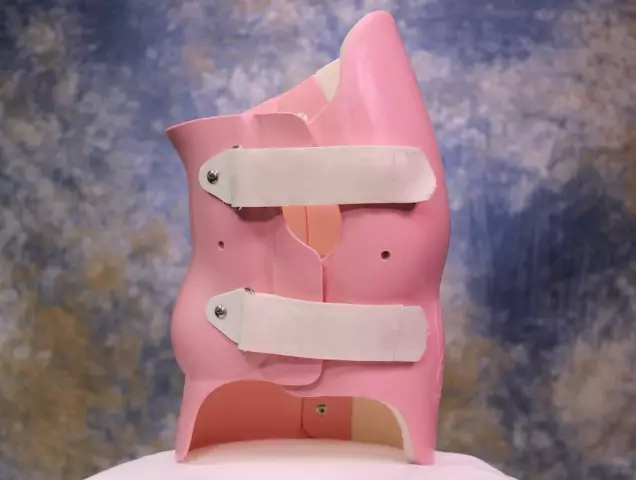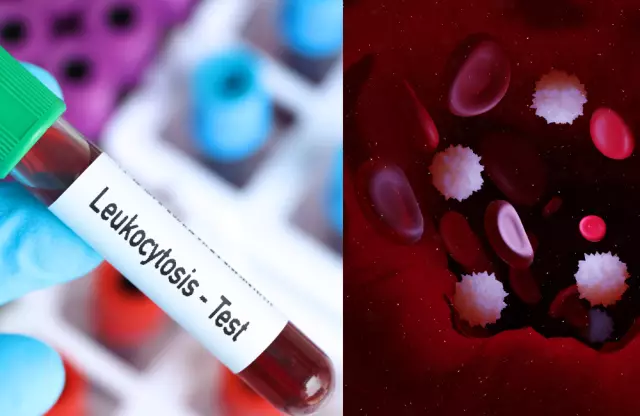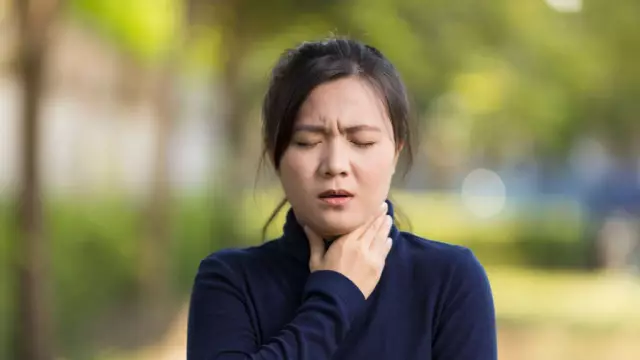- Author Rachel Wainwright [email protected].
- Public 2023-12-15 07:39.
- Last modified 2025-11-02 20:14.
Scoliosis

The curvature of the spine in one direction or another from the normal position is called scoliosis. Its localization is possible in the cervical, thoracic and lumbar regions. Among all diseases of the spine, scoliosis is the most common.
The main danger of scoliosis lies in the fact that it is not just a cosmetic defect, but a deformity of the spinal column, which is a serious health threat. The displacement of the vertebrae, as well as the adjacent vessels and nerves, leads to disruption of the normal functioning of all systems and organs. As a result, scoliosis contributes to the development of various diseases, the progression of back pain, limitation of the range of active movements in the spine and chest deformities.
Among the main causes of scoliosis, experts call a hereditary predisposition to impaired growth of bones, muscle and connective tissues, as well as spontaneous gene mutation, disorders of the central nervous system and a sedentary lifestyle.
Classification of scoliosis
Scoliosis is a multifaceted disease, when making a diagnosis, specialists are guided by anatomical features, the patient's age, localization and shape of the curvature. The reasons that can provoke a curvature of the spine are also taken into account.
Distinguish between simple and complex scoliosis. In the first case, the disease occurs almost immediately after birth due to any defects such as shortening of the limb or an inflammatory process in the tissues next to the spine. After eliminating the cause that caused the curvature, recovery occurs.
Complex scoliosis is subdivided into congenital and acquired. In most cases, the curvature of the spine appears as a result of hereditary diseases of connective or bone tissue, underdevelopment or deformation of the vertebrae, as well as after neuroinfections.
Acquired scoliosis occurs with rheumatism, rickets, after paralysis of various etiologies, trauma, and extensive burns.
A special danger is the so-called school scoliosis, when an absolutely healthy child develops a curvature of the spine in one direction due to long sitting at an incorrectly arranged desk, carrying a bag in the same hand and similar actions.
In terms of the number of bends, scoliosis is simple when the spinal column is displaced in one direction, complex when there are several deviations in different directions, and total, when there are many curvatures.
Depending on the localization, scoliosis of the cervicothoracic, thoracic, lumbar-thoracic, lumbar and combined types is distinguished.
Scoliosis is also distinguished by the time of their appearance. If signs of the disease are observed between the first and second year after birth, then we are talking about infantile scoliosis. Juvenile is a curvature of the spine that occurs between the ages of four and six. Scoliosis, which developed at the age of 10-14 years, was called adolescent.
Scoliosis grade
In total, there are four degrees of scoliosis:

The first degree is characterized by a stoop, an asymmetric waist, flat shoulders and a constantly lowered head. In a standing position, the curvature of the spinal column is almost imperceptible. Scoliosis of the 1st degree is determined only when the body is tilted forward, when the line of one shoulder is slightly overestimated.
With scoliosis of the 2nd degree, there is a slight asymmetry of the contours of the neck, a slight lowering of the pelvis on the side of the lesion. The curvature of the spine becomes noticeable when standing. When the trunk is tilted forward at grade 2 of scoliosis, a bulge appears in the thoracic region.
A pronounced asymmetry of the scapula and a noticeable curvature of the arch of the spine are characteristic of the third degree of scoliosis. The rib cage is deformed so much that some ribs sink in, while others protrude, muscle contracture is determined. When leaning forward, the patient has a well-defined rib hump.
Gross deformity of the spine, stretching of muscles in the curvature zone, pronounced rib hump, sinking of the ribs in the place of concavity are the hallmarks of the fourth degree of scoliosis.
Scoliosis treatment
When prescribing treatment for scoliosis, attention is paid to the patient's age, the degree of curvature of the spinal column and the type of disease. In modern medicine, a conservative and surgical approach to solving the problem is practiced. The intervention of surgeons is advisable for advanced forms of the third and fourth degrees. Treatment of scoliosis of the first two degrees, as well as uncomplicated forms of grade 3, is carried out on an outpatient basis.
The main tasks in the treatment of scoliosis are the desire to reduce the deformity of the spine, straighten the back, slow down the progression of the disease, increase the range of movements performed and improve metabolic processes.

The emphasis in the treatment of scoliosis is on individual therapeutic exercises, massage, orthopedic correction, physiotherapy and swimming. Exercises for scoliosis are selected in such a way that all muscle groups of the back are involved during exercise. As a result, the muscle corset will be strengthened, thanks to which the spinal column is held in the correct position, posture will improve, the condition will stabilize, and a general strengthening effect will be achieved.
It is not recommended to perform exercises aimed at increasing the flexibility of the spine with scoliosis. Physiotherapy exercises are indicated for all stages of the disease, but the best result can be achieved by performing specially selected exercises for scoliosis of the first two degrees.
Sometimes chiropractors are used to get rid of the curvature. But experts warn that manual therapy can only be used in conjunction with other treatment methods. In addition, with some symptoms of grade 1 scoliosis or other stages of the disease, for example, severe muscle weakness or great mobility of the spine, manual exposure is contraindicated.
The course of treatment for scoliosis is always long, even in the early stages. Only after some time will it be possible to say with confidence that the disease is giving way.
Prevention of scoliosis
The most important rule of prevention is maintaining correct posture. In addition, it is necessary to ensure at least a minimum level of physical activity, which includes walking, running, swimming and, of course, gymnastics.
To prevent scoliosis, exercises should be aimed at strengthening the muscles of the back, chest and abdominal muscles. In addition to the fact that the correct posture is developed, with scoliosis of 1 degree, figure flaws are corrected, the skill of owning your body appears, the blood supply to the internal organs improves and metabolic processes are normalized.
In childhood and adolescence, it is necessary to pay attention to good nutrition and adherence to the daily regimen. At school and at home, the child's workplace should be appropriate for age and height.
YouTube video related to the article:
The information is generalized and provided for informational purposes only. At the first sign of illness, see your doctor. Self-medication is hazardous to health!






